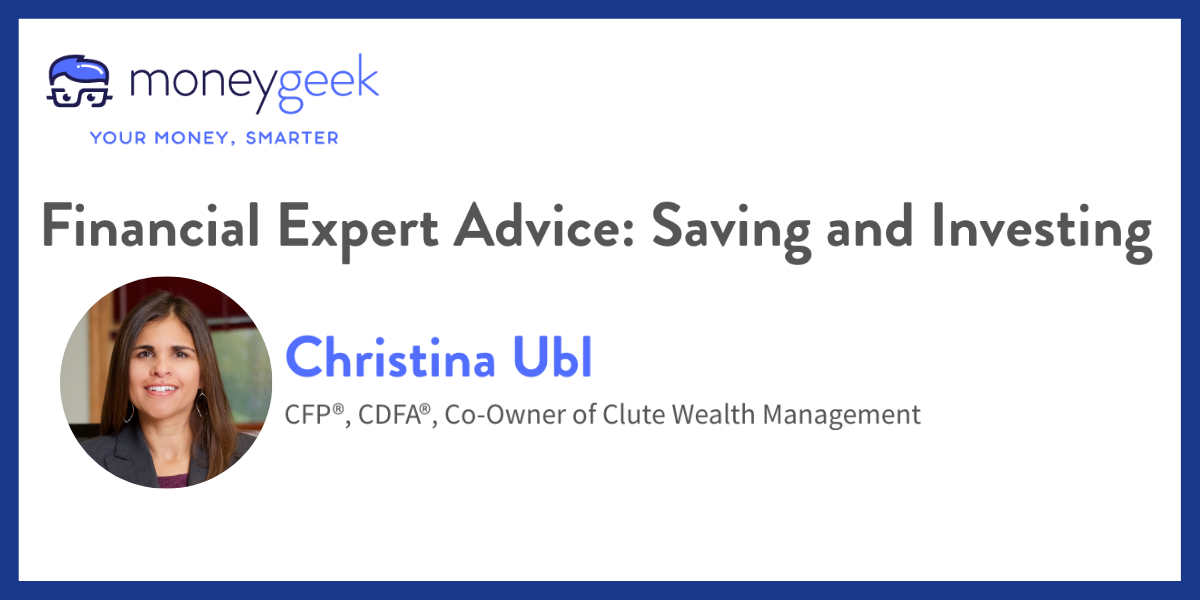
Christina was featured as a guest expert in the MoneyGeek article "How to Start Saving and Investing". She answered questions and provided insight about investing for beginners, how to evaluate if you are in a place where you should begin investing, and answered other common questions.
You can read excerpts of Christina's interview below and you can find it here on the MoneyGeek website.
Christina's Excerpt:
How much should beginners invest in stocks and bonds? And when is a good time to increase those investments?
How much a beginner should invest in stocks and bonds is based on your financial plan and a current snapshot of your financial situation.
Ask yourself:
- Are you paying only the monthly minimum on credit cards or other high-interest debt? If so, investing in stocks and bonds should wait until your revolving debts are paid off.
- Can your emergency fund cover 3–6 months of living expenses? If not, it’s smartest to wait to invest in stocks and bonds until your emergency fund is adequate.
- Are you progressing on savings for your mid-term financial goals — like a new car or next year’s vacation? Will your mid-term goals be derailed by investing in stocks and bonds, which have a longer time horizon?
- Can you invest in stocks and bonds through an employer’s retirement plan with a match? If so, you want to invest the maximum amount your employer will match — for what many consider to be an immediate 100% return on your investment.
If you are a beginner because you are a younger adult, investments in stocks and bonds outside a company’s retirement plan should be limited until high-interest rate student loan obligations have been met.
If you are a beginner because of a life transition — for example, the recent death of your spouse, divorce or, more happily, a sudden inheritance or lottery win — then proceed carefully. Emotions and money are a dangerous combination. Start by determining the amount of money you can afford to lose without severe angst, divide that amount by 12 and invest that figure each month for one year. You will gain experience and the emotional buffer you need before increasing your investments.
How do you choose the best stocks and bonds to invest in?
When you are beginning, keep the need for diversification and low fees top of mind — and then invest in what you know and believe in. Many beginners feel most comfortable investing in what is known as a target-date fund1, which can include a diversified mix of stocks and bonds based on your current age and expected retirement date. For those looking to match their money with their values, themed target-date funds are available that focus on specific environmental, social and governance (ESG) factors2 you care about, such as women-owned businesses or climate change.
What advice can you give people who are living paycheck to paycheck and want to start investing?
If you are living paycheck to paycheck, with few exceptions, it is better to wait before you start investing. Ask yourself:
- What spending behaviors and monthly expenses can be changed? If you have a daily $5 coffee shop habit and switch to carrying your travel mug from home and depositing your $5 into a savings account, you could have a $100 savings buffer in one month. (For help developing a process for changing and sustaining new behaviors, check out the evidence-based book “Atomic Habits: Tiny Changes, Remarkable Results” by James Clear.)
- Do you have an opportunity to increase your income and save the additional dollars? Depending on your employer, asking for a raise may be appropriate, or perhaps moonlighting at a second job for even a few months can help stabilize your economic situation.
If investing now is still a priority, then enroll in your employer’s retirement plan if eligible. Contributions will occur automatically, making saving easier. An added benefit to investing in an employer-sponsored retirement plan is that there are typically no transaction costs or tax implications for internal changes, providing an inexpensive way to gain familiarity with investing.
Can you use an investment app and work with a financial advisor? Is it a good idea? How many investment avenues can you have?
Yes, using an investment app and working with a financial advisor is an option. But whether it is a good idea depends on if you have a financial plan developed by a CFP® and your investing personality. Some beginning investors, either younger adults or those in a life transition, may sleep better at night if the investment budget in their financial plan is kept on track by a financial advisor while they, as the investor, handle a smaller, more active trading account directly through an investment app. Such an arrangement can limit your trading costs and your risk exposure. Other beginning investors may feel anxious trying to keep up with the barrage of daily financial news or dealing with one more technology and more screen time on their smartphone — you likely know which camp you fall into! The optimal number of investment avenues for your needs should reflect your current investments and progress towards your financial goals, your level of knowledge and your tolerance for risk.
1The target date is the approximate date when investors plan to start withdrawing their money. The principal value of a target fund is not guaranteed at any time, including at the target date.
2Socially Responsible Investing (SRI) / Environmental Social Governance (ESG) investing has certain risks based on the fact that the criteria excludes securities of certain issuers for non-financial reasons and, therefore, investors may forgo some market opportunities and the universe of investments available will be smaller.


